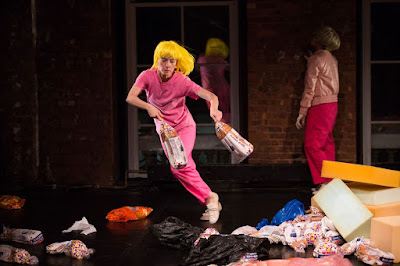 |
| Wesley Chavis in his solo, Ku In Tuo Muah, a DoublePlus presentation of Gibney Dance, curated by Dean Moss (photos: Scott Shaw) |
In Ku In Tuo Muah, soloist Wesley Chavis's "physicalizing [of] his worship"--to use Gibney DoublePlus curator Dean Moss's words--adopts a widespread human practice with ancient origins, still active, for example, in the Black churches of Chavis's own Southern upbringing. Worship of higher, disembodied powers is often a practice of the body, and extreme, transcendent states of mind have always been powerfully accessed through the body, say in ritual dancing or ingestion of sacred hallucinogens.
Ku In Tuo Muah, like most dance works I get to see, might have many behind-the-scenes influencers and supporters. But the few program credits--for "concept, audio/visual design and, of course, performance--go to Chavis solely, no stated collaborators. For the audience, this solo offers a privileged, if complicated, view of a path engaged upon decidedly alone. It's an internal, private, abstract exploration with challenges only one man can know.
Even the sounds that arise from this exploration are sounds of the breathing and gasping (and maybe unseen crying) of a human body. The emphasis on peeling off and shedding articles of clothing suggests continuous self-transformation and digging down to the person beneath persona beyond the grip and labeling of an outside world.
Stopping to remove his shoes and shirt is the first thing Chavis does as he walks through the door into the theater called Studio H at Gibney Dance: Agnes Varis Performing Arts Center. It's like watching a weary man come home.
At first, he does not enter the portion of the space directly in front of the audience seats and will not for a long time. Instead, he occupies that stage-left area near the mirrors. So we must look over, slightly sideways, to watch him. It's a brilliant distancing device. You see me, but you have to work a little for it. I'm still over here in my somewhat private space, and I'm going to make you feel like the voyeurs you are.
So we watch as he proceeds to disturb and distort the functional harmony of his body, and we watch the wrenching and shedding and listen to the ragged gasps. His entrance to the main section of the space, which is covered in shiny, black plastic introduces more sound--the noise of him scrunching that floor covering as he continues to contort and scrunch up his body.
At the end, Chavis simply gathers up his clothing and exits the theater, remaining someone seen with the physical eyes but not really known--an impressive, even beautiful, but remote performer. His dance, his ritual, remained--for me, at least--a journey monitored but not truly shared, and I note that with acceptance and respect.
 |
| Cori Olinghouse (above and below) in GRANDMA (photos: Scott Shaw) |
What Cori Olinghouse calls Clown Therapy draws from The Fool's power to look at things sideways upside down and dismantle the everyday mundane and how we habitually see it. Her GRANDMA--an interdisciplinary piece for herself, Martita Abril and Kate Watson Wallace--is wacky without (for the most part) being funny. It really isn't clowning in the conventional manner. Its pace is most often glacial with stiff, stooped, dazed dancers shambling about a space littered with cheap snack food. Their overpowering, face-obscuring wigs and lipstick pink costumes, the recognizable snack food product placement, though--that's where the funny would normally be situated. The clown proffering little plastic-wrapped cupcakes could not be more pathetic as she apparently cannot bring herself to approach more than two people in the audience, her feet repeatedly colliding with the plastic cups that earlier exploded onto the floor right in front of us.
My sympathetic attention cleaves to one performer momentarily and sadly stuck facing a corner, as if in shame, confusion or both. The old-fashioned tv screen at the center of it all gives back nothing but static. Attempts to mop up the mess--or stuff slices of Wonderbread under one's wig--are futile, half-hearted and soon abandoned. The overall ineptitude and visual disarray speak to a growing upheaval at the core of something, and that must be the therapy Olinghouse chooses to agitate.
Olinghouse's inclusion of two pop hits--George Michael's "Father Figure" and Wham!'s "Everything She Wants"--will launch an army of earworms, I can attest. The songs underscore a displeasure with warped values, excess consumption and the detritus it generates.
Wesley Chavis + Cori Olinghouse concludes tonight with a performance at 8pm. For information and tickets, click here.
Gibney Dance: Agnes Varis Performing Arts Center
280 Broadway (entrance: 53A Chambers Street), Manhattan
(map/directions)












No comments:
Post a Comment